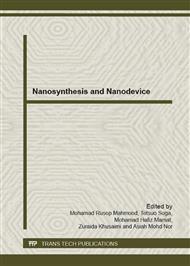[1]
Ping-Feng Yang, Hua-Chiang Wen, Sheng-Rui Jian, Yi-Shao Lai, Sean Wu, Rong-Sheng Chen, Characteristics of ZnO thin films prepared by radio frequency magnetron sputtering, Microelectronics Reliability 48 (2008) 389-394.
DOI: 10.1109/impact.2007.4433597
Google Scholar
[2]
R. Ondo-Ndong, F. Pascal-Delannoy, A. Boyer, A. Giani, A. Foucaran, Structural properties of zinc oxide thin films prepared by r. f. magnetron sputtering, Materials Science and Engineering: B 97 (2003) 68-73.
DOI: 10.1016/s0921-5107(02)00406-3
Google Scholar
[3]
Sukhvinder Singh, R. S. Srinivasa, S. S. Major, Effect of substrate temperature on the structure and optical properties of ZnO thin films deposited by reactive rf magnetron sputtering, Thin Solid Films 515 (2007) 8718-8722.
DOI: 10.1016/j.tsf.2007.03.168
Google Scholar
[4]
P. Nunes, E. Fortunato, R. Martins, Influence of the post-treatment on the properties of ZnO thin films, Thin Solid Films 383 (2001) 277-280.
DOI: 10.1016/s0040-6090(00)01577-7
Google Scholar
[5]
M. Suchea, S. Christoulakis, K. Moschovis, N. Katsarakis, G. Kiriakidis, ZnO transparent thin films for gas sensor applications, Thin Solid Films 515 (2006) 551-554.
DOI: 10.1016/j.tsf.2005.12.295
Google Scholar
[6]
M.K. Hossain, S.C. Ghosh, Y. Boontongkong, C. Thanachayanont, J. Dutta, Growth of zinc oxide nanowires and nanobelts for gas sensing applications, Journal of Metastable and Nanocrystalline Materials 23 (2005) 27-30.
DOI: 10.4028/www.scientific.net/jmnm.23.27
Google Scholar
[7]
S. H. Jeong, S. Kho, D. Jung, S. B. Lee, and J. H. Boo, Deposition of aluminum-doped zinc oxide films by RF magnetron sputtering and study of their surface characteristics, Surface and Coatings Technology 174–175 (2003) 187-192.
DOI: 10.1016/s0257-8972(03)00600-5
Google Scholar
[8]
M. Hafiz Mamat, S.W.A. Wan, M.Z. Musa, Z. Khusaimi, M.F. Malek, S. Muhamad, D.M. Sin, B. Mahmood, M. Rusop, Effect of Oxygen Flow Rate on the Properties of Nanocolumnar ZnO Thin Films Prepared Using Radio Frequency Magnetron Sputtering System for Ultraviolet Sensor Applications, Advanced Materials Research 364 (2012).
DOI: 10.4028/www.scientific.net/amr.364.1
Google Scholar
[9]
J. H. H. Zhu, E. Bunte, S. M Huang, Oxygen influence on sputtered high rate ZnO: Al films from dual rotatable ceramic targets, Applied Surface Science 256 (2010) 4601-4605.
DOI: 10.1016/j.apsusc.2010.02.057
Google Scholar
[10]
I. Sayago, M. Aleixandre,L. Ares, M.J. Fernandez, J.P. Santos, J. Gutierrez, M.C. Horrillo, The effect of the oxygen concentration and the rf power on the zinc oxide films properties deposited by magnetron sputtering, Applied Surface Science 245 (2005).
DOI: 10.1016/j.apsusc.2004.10.035
Google Scholar
[11]
T. Ghosh, D. Basak, Effect of oxygen flow rate and radio-frequency power on the photoconductivity of highly ultraviolet sensitive ZnO thin films grown by magnetron sputtering technique, Materials Research Bulletin 46 (2011) 1975–(1979).
DOI: 10.1016/j.materresbull.2011.07.019
Google Scholar
[12]
P. T. Hsieh, Y. C. Chen, K. S. Kao, C. M. Wang, Structural effect on UV emission properties of high-quality ZnO thin films deposited by RF magnetron sputtering, Physica B: Condensed Matter 392 (2007) 332-336.
DOI: 10.1016/j.physb.2006.11.043
Google Scholar


